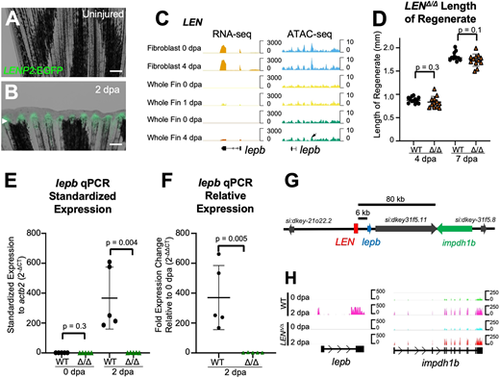Fig. 6
- ID
- ZDB-FIG-231215-75
- Publication
- Thompson et al., 2020 - Identification and requirements of enhancers that direct gene expression during zebrafish fin regeneration
- Other Figures
- All Figure Page
- Back to All Figure Page
|
LEN is essential for lepb expression during fin regeneration. (A,B) LENP2:EGFP fish display EGFP expression in the blastema by 2 dpa, as reported by Kang et al. (2016). Arrow indicates amputation plane. Scale bars: 300 μm. (C) Browser tracks indicating the LEN TREE (arrow) near the upregulated lepb transcript in regenerating fibroblast and whole fin tissue. While LEN is accessible in whole fin and fibroblast tissue, its accessibility is not considered dynamic during regeneration. Tracks represent normalized combined replicates. (D) Lengths of regenerating fins are similar in LENΔ/Δ and wild-type fish (n=12). Paired two-tailed t-tests were performed to indicate significance. Data are mean±s.d. (E,F) qPCR analysis of lepb transcript levels in in LENΔ/Δ and WT fins. lepb is undetectable in 2 dpa regenerating LENΔ/Δ fish. Each biological replicate pool of three fins each was performed in technical duplicate, and paired two-tailed t-tests were performed to indicate significance. (n=5). Data are mean±s.d. (G) Genomic region immediately surrounding LEN. lepb and impdh1b are induced during fin regeneration. (H) RNA-seq of LENΔ/Δ and wild-type 0 and 2 dpa regenerates. Tracks indicate an absence of lepb expression at 2 dpa in LENΔ/Δ fish, whereas impdh1b transcript levels are increased similarly in both wild type and LENΔ/Δ upon fin amputation. Tracks represent individual replicates. |

